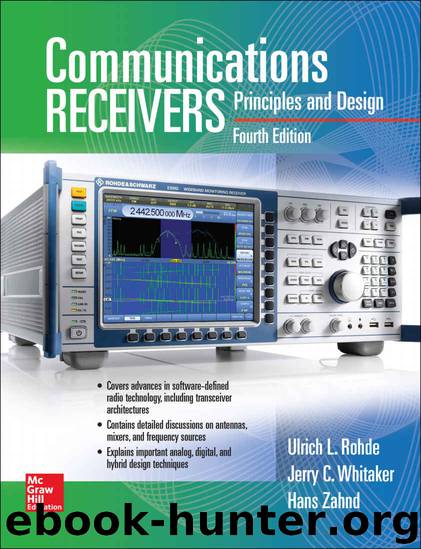Communications Receivers, Fourth Edition by Ulrich L. Rohde & Jerry C. Whitaker

Author:Ulrich L. Rohde & Jerry C. Whitaker [Rohde, Ulrich L.]
Language: eng
Format: azw3
Publisher: McGraw-Hill Education
Published: 2017-03-10T05:00:00+00:00
Figure 6.11 shows an overdriven amplifier and its third harmonic. The dashed line represents a linear gain. It is important to notice that the output level begins to decrease at a certain drive level even when the input signal is further increased. This situation leads to an instability within the predistortion loop and must be avoided under all possible load conditions. Secure operation is maintained when the amplifier is driven slightly higher than the 1 dB compression point.
FIGURE 6.11 Gain and third harmonic with k1 = 10 and k3 = 2.
The result of a linearized SSB transmitter by means of the adaptive predistortion are presented in Figure 6.12. The third- and fifth-order intermodulation products are reduced by −64 dBc or −70 dBPEP . The marker points to the carrier frequency. It is clearly visible that the intermodulation products within the passband of the 5-kHz low-pass filter are cancelled, whereas the seventh- and ninth-order products are even higher than without predistortion (see Figure 6.13). A possible reason is that these products are further distorted by the rapidly changing phase on the filter slope of the LPF.
Download
This site does not store any files on its server. We only index and link to content provided by other sites. Please contact the content providers to delete copyright contents if any and email us, we'll remove relevant links or contents immediately.
| Automotive | Engineering |
| Transportation |
Whiskies Galore by Ian Buxton(41880)
Introduction to Aircraft Design (Cambridge Aerospace Series) by John P. Fielding(33064)
Small Unmanned Fixed-wing Aircraft Design by Andrew J. Keane Andras Sobester James P. Scanlan & András Sóbester & James P. Scanlan(32743)
Craft Beer for the Homebrewer by Michael Agnew(18140)
Turbulence by E. J. Noyes(7936)
The Complete Stick Figure Physics Tutorials by Allen Sarah(7307)
Kaplan MCAT General Chemistry Review by Kaplan(6867)
The Thirst by Nesbo Jo(6828)
Bad Blood by John Carreyrou(6552)
Modelling of Convective Heat and Mass Transfer in Rotating Flows by Igor V. Shevchuk(6391)
Learning SQL by Alan Beaulieu(6211)
Weapons of Math Destruction by Cathy O'Neil(6146)
Man-made Catastrophes and Risk Information Concealment by Dmitry Chernov & Didier Sornette(5921)
Digital Minimalism by Cal Newport;(5664)
Life 3.0: Being Human in the Age of Artificial Intelligence by Tegmark Max(5474)
iGen by Jean M. Twenge(5366)
Secrets of Antigravity Propulsion: Tesla, UFOs, and Classified Aerospace Technology by Ph.D. Paul A. Laviolette(5309)
Design of Trajectory Optimization Approach for Space Maneuver Vehicle Skip Entry Problems by Runqi Chai & Al Savvaris & Antonios Tsourdos & Senchun Chai(5011)
Pale Blue Dot by Carl Sagan(4912)
